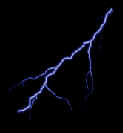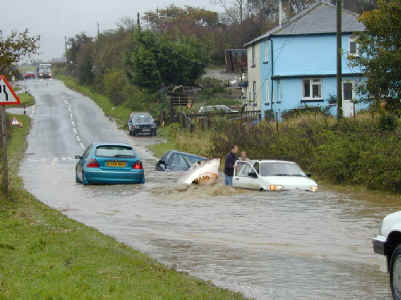Chapter 21: STORM DRIVING
Driving before, during and after a storm (or cyclone) can be extremely hazardous. The chance of having a vehicle crash whilst driving in a storm is millions of times greater than the chance of being struck by lightening.
With the additional dangers and difficulties created during a storm, a responsible driver should plan their driving time and route to ensure they are not on the road during a storm event.
However as you are trying to avoid a storm so to is every other driver.
Each second you continue driving as a storm sweeps towards you, the chance of being involved in a crash increases dramatically.
Think about it, your mirrors are filled with ominous black clouds and lightening, the wind howls across the road, debris flies everywhere; as you race for home or shelter so is everyone else.
The last thing on every drivers mind is road rules, speed limits and being patient.
The fear of getting caught in the storm far outweighs the fear of a speeding ticket. Anyway how many police officers are going to pull anyone over and stand in a storm writing a ticket.
So before a storm can be an extremely dangerous period to drive as anarchy and desperation rule over common sense and caution.
DURING A STORM
The dangers only escalate once a storm strikes, now the road environment throws new challenges at the unwary. The combination of strong winds, heavy rain, hail and lightening create new hazards.
Strong winds can push your vehicle and other vehicles of track and blow debris such as branches, rubbish, trees and even power lines onto the road.
Obviously heavy rain makes the roads slippery and reduces visibility but the torrent of rainfall associated with a storm can cause flooding and produce large puddles which can induce aquaplaning.
1998 Stupid road sign of the year award winner
Hail is probably the most dangerous aspect of driving in a storm.
When it hails a drivers attention is diverted from the road to the damage occurring to the vehicle.
It is a sound as unforgettably memorable as having a crash or locking the brakes; the sound of hail denting of your vehicles exterior. The onset of hail creates another situation in which drivers will do whatever it takes to reach shelter as quickly as possible.
Lastly lightening poses a remote risk of striking your vehicle but a greater risk of striking a tree (perhaps one your parked or driving under) or a power pole; sending hazards onto the road.
A final factor of driving during a daytime storm is a reduction in light levels.
AFTER A STORM
Even after a storm passes the danger remains.
The bitumen still remains wet and slippery, any melting hail stones act like loose gravel and debris can litter the road. In addition potholes can form which can if large or deep enough damage your vehicles wheels, tyres and suspension.
Heavy rain can create landslides, washouts and subsidence of the road surface.
Even worse the rain can result in flash floods.
TIPS FOR DRIVING IN STORMS
- Plan the time and route of travel to avoid threatening storms
- If you cannot avoid the storm; consider stopping.
- Remember it is better to arrive late than not arrive at all!
- Be prepared for the reckless actions of other drivers.
- Turn your headlights on, see and be seen.
- Hold the steering wheel in both hands ready for aquaplaning.
- Leave room to manoeuvre.
- Drive to the prevailing conditions
- Be ready for the unexpected.
TIPS FOR DEALING WITH ELECTRICITY
Whether due to a lightening strike, falling power lines or a crash into an electrical pole that brings down the cable there are some important considerations when dealing with high voltage electricity.
If a fallen wire is touching a vehicle wait inside for help.
If you must get out, jump clear without touching the ground and the vehicle at the same time.
Shuffle your feet rather than run. Keep both feet close together on the ground to prevent electricity from running through the body.
If you witness, someone else in danger, STAY CLEAR and call for help.
(Written by Joel Neilsen, Managing Director, Safe Drive Training)



